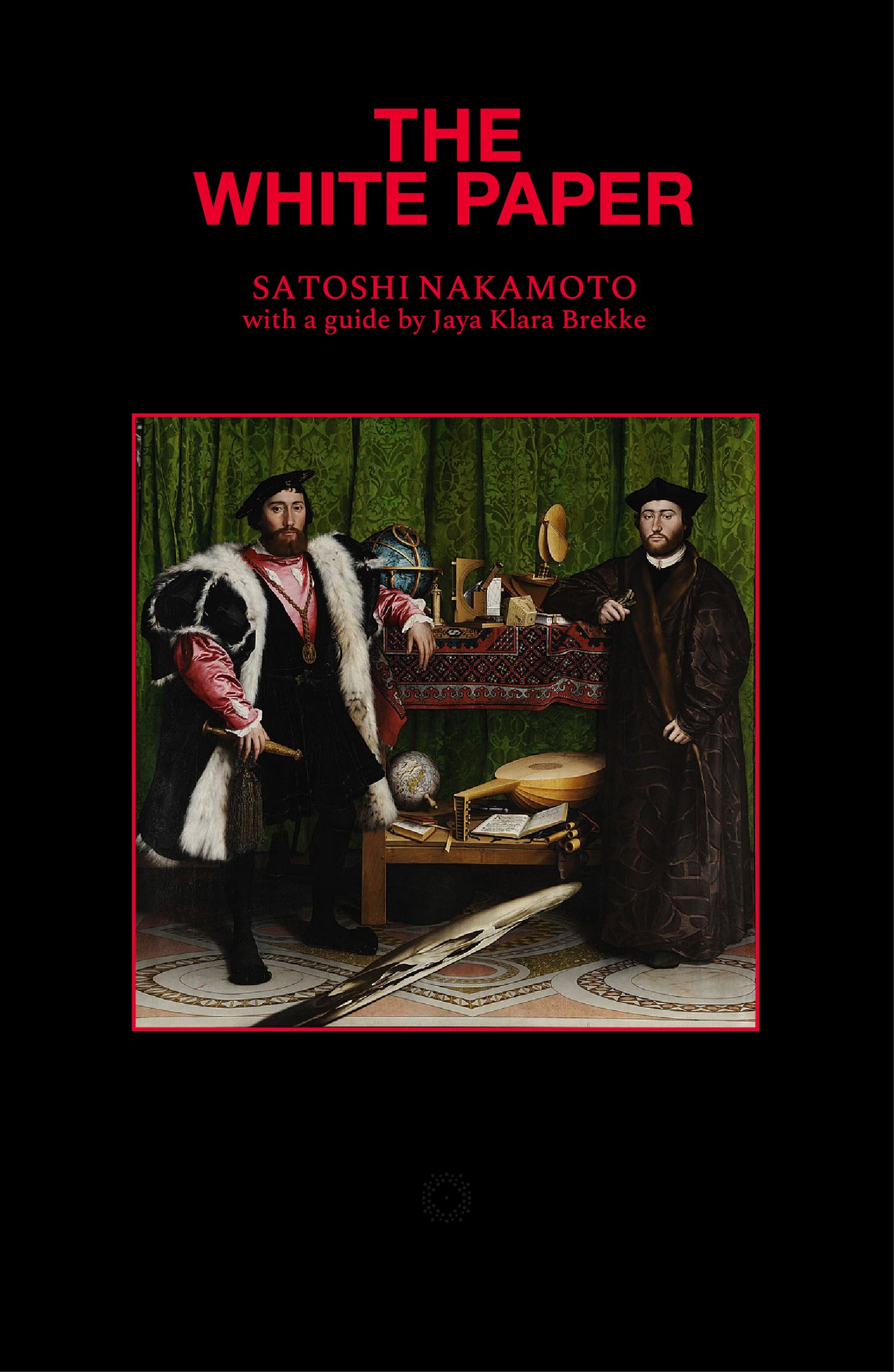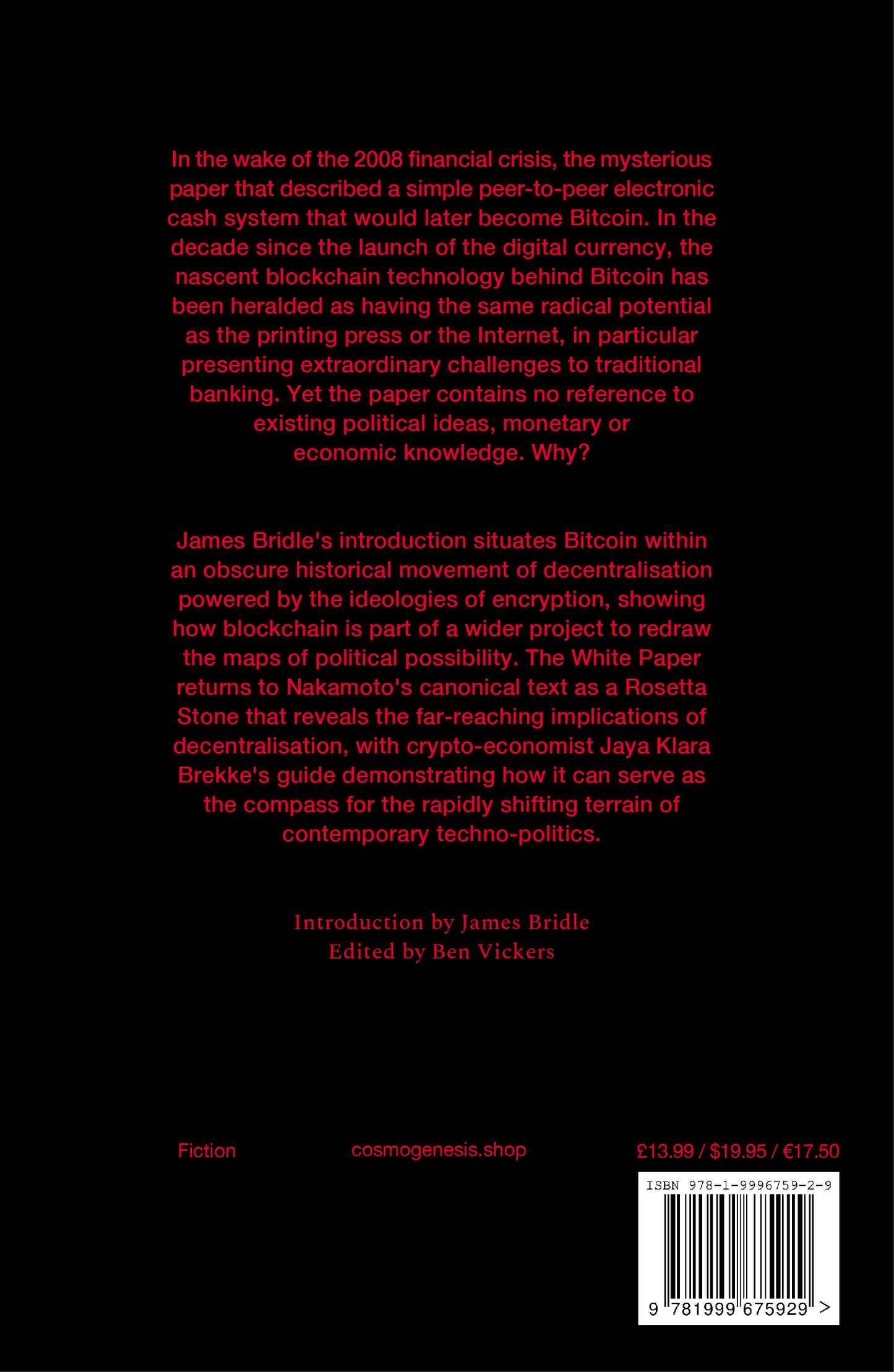1
/
of
2
The White Paper
The White Paper
By Satoshi Nakamoto
Guide by Jaya Klara Brekke
Introduction by James Bridle
Edited by Ben Vickers
In the wake of the 2008 financial crisis, the mysterious Satoshi Nakamoto published a revolutionary white paper that described a simple peer-to-peer electronic cash system that would later become Bitcoin, laying the foundations for the technical innovation known as the blockchain. In the decade since its publication, the nascent technology behind cryptocurrency has become recognised holding the same transformative potential of the printing press or the internet, set to impact our sense of identity and provenance as much as finance. It has disrupted traditional financial markets with a spectacular explosion in value, paved the way for thousands of similar digital currencies and laid the groundwork for a decentralised future of the web. But what does it mean for everyday life?
The White Paper returns to the document that started it all, taking Nakamoto’s text as a Rosetta Stone to decode the meaning of blockchain for contemporary society. This guide to the innovative technolog...
Introduction by James Bridle
Edited by Ben Vickers
In the wake of the 2008 financial crisis, the mysterious Satoshi Nakamoto published a revolutionary white paper that described a simple peer-to-peer electronic cash system that would later become Bitcoin, laying the foundations for the technical innovation known as the blockchain. In the decade since its publication, the nascent technology behind cryptocurrency has become recognised holding the same transformative potential of the printing press or the internet, set to impact our sense of identity and provenance as much as finance. It has disrupted traditional financial markets with a spectacular explosion in value, paved the way for thousands of similar digital currencies and laid the groundwork for a decentralised future of the web. But what does it mean for everyday life?
The White Paper returns to the document that started it all, taking Nakamoto’s text as a Rosetta Stone to decode the meaning of blockchain for contemporary society. This guide to the innovative technolog...
Guide by Jaya Klara Brekke
Introduction by James Bridle
Edited by Ben Vickers
In the wake of the 2008 financial crisis, the mysterious Satoshi Nakamoto published a revolutionary white paper that described a simple peer-to-peer electronic cash system that would later become Bitcoin, laying the foundations for the technical innovation known as the blockchain. In the decade since its publication, the nascent technology behind cryptocurrency has become recognised holding the same transformative potential of the printing press or the internet, set to impact our sense of identity and provenance as much as finance. It has disrupted traditional financial markets with a spectacular explosion in value, paved the way for thousands of similar digital currencies and laid the groundwork for a decentralised future of the web. But what does it mean for everyday life?
The White Paper returns to the document that started it all, taking Nakamoto’s text as a Rosetta Stone to decode the meaning of blockchain for contemporary society. This guide to the innovative technology shows how it holds up a mirror to our understanding of the world, both timeless and mutating: from the archetypal origin story, to concepts of trust and value, and the changing shapes of power and privacy.
In an acute and definitive Introduction, James Bridle, leading technologist, artist and author of New Dark Age, charts the rise of blockchain from its roots in clandestine online cultures. Delving into the first conversations between initial members of the Bitcoin community - a disparate group of cyber ideologues ranging from right-wing Libertarians to radical Web 2.0 utopian, Bridle shows how they shed light on the cryptographic imagination that points towards the future of the Bitcoin dream. Through the lens of encryption as philosophy and practice, Bridle examines the continuing debates around the meaning of money, democratic values and security in an era of surveillance capitalism.
Fully annotated with key secondary texts, The White Paper presents new perspectives on the radical paper.
ISBN: 978-1-9996759-2-9
Jaya Klara Brekke writes, does research and speaks on the political economy of blockchain and consensus protocols, focusing on questions of politics, redistribution and power in distributed systems. She is the author of the B9Lab ethical training module for blockchain developers, and the Satoshi Oath, a hippocratic oath for blockchain development. She is writing a PhD with the preliminary title Distributing Chains, three strategies for thinking blockchain politically.
James Bridle is an artist and writer working across technologies and disciplines. His artworks have been commissioned by galleries and institutions and exhibited worldwide and on the internet. His writing on literature, culture and networks has appeared in magazines and newspapers including Wired, Domus, Cabinet, the Atlantic, the New Statesman, the Guardian, the Observer and many others, in print and online. He lectures regularly at conferences, universities, and other events. New Dark Age, his book about technology, knowledge, and the end of the future, was published by Verso (UK & US) in 2018. His work can be found at http://jamesbridle.com.
Satoshi Nakamoto is the identity used by the unknown person or people who developed Bitcoin, authored the Bitcoin white paper, and created and deployed the first Bitcoin implementation. As part of the implementation, they also devised the first blockchain database. Satoshi Nakamoto ceased public involvement with Bitcoin at the end of 2010; their last public post was made in 2014 as a rebuttal to claims on the ‘true’ nature of Satoshi’s identity. During Bitcoin's peak in December 2017, the Satoshi Nakamoto identity could lay claim to a fortune worth over $19 billion, making Nakamoto possibly the 44th richest person in the world at that time. To this day both the public identity and Bitcoin wallet attached to the identity of Satoshi Nakamoto remain inactive.
Introduction by James Bridle
Edited by Ben Vickers
In the wake of the 2008 financial crisis, the mysterious Satoshi Nakamoto published a revolutionary white paper that described a simple peer-to-peer electronic cash system that would later become Bitcoin, laying the foundations for the technical innovation known as the blockchain. In the decade since its publication, the nascent technology behind cryptocurrency has become recognised holding the same transformative potential of the printing press or the internet, set to impact our sense of identity and provenance as much as finance. It has disrupted traditional financial markets with a spectacular explosion in value, paved the way for thousands of similar digital currencies and laid the groundwork for a decentralised future of the web. But what does it mean for everyday life?
The White Paper returns to the document that started it all, taking Nakamoto’s text as a Rosetta Stone to decode the meaning of blockchain for contemporary society. This guide to the innovative technology shows how it holds up a mirror to our understanding of the world, both timeless and mutating: from the archetypal origin story, to concepts of trust and value, and the changing shapes of power and privacy.
In an acute and definitive Introduction, James Bridle, leading technologist, artist and author of New Dark Age, charts the rise of blockchain from its roots in clandestine online cultures. Delving into the first conversations between initial members of the Bitcoin community - a disparate group of cyber ideologues ranging from right-wing Libertarians to radical Web 2.0 utopian, Bridle shows how they shed light on the cryptographic imagination that points towards the future of the Bitcoin dream. Through the lens of encryption as philosophy and practice, Bridle examines the continuing debates around the meaning of money, democratic values and security in an era of surveillance capitalism.
Fully annotated with key secondary texts, The White Paper presents new perspectives on the radical paper.
ISBN: 978-1-9996759-2-9
Jaya Klara Brekke writes, does research and speaks on the political economy of blockchain and consensus protocols, focusing on questions of politics, redistribution and power in distributed systems. She is the author of the B9Lab ethical training module for blockchain developers, and the Satoshi Oath, a hippocratic oath for blockchain development. She is writing a PhD with the preliminary title Distributing Chains, three strategies for thinking blockchain politically.
James Bridle is an artist and writer working across technologies and disciplines. His artworks have been commissioned by galleries and institutions and exhibited worldwide and on the internet. His writing on literature, culture and networks has appeared in magazines and newspapers including Wired, Domus, Cabinet, the Atlantic, the New Statesman, the Guardian, the Observer and many others, in print and online. He lectures regularly at conferences, universities, and other events. New Dark Age, his book about technology, knowledge, and the end of the future, was published by Verso (UK & US) in 2018. His work can be found at http://jamesbridle.com.
Satoshi Nakamoto is the identity used by the unknown person or people who developed Bitcoin, authored the Bitcoin white paper, and created and deployed the first Bitcoin implementation. As part of the implementation, they also devised the first blockchain database. Satoshi Nakamoto ceased public involvement with Bitcoin at the end of 2010; their last public post was made in 2014 as a rebuttal to claims on the ‘true’ nature of Satoshi’s identity. During Bitcoin's peak in December 2017, the Satoshi Nakamoto identity could lay claim to a fortune worth over $19 billion, making Nakamoto possibly the 44th richest person in the world at that time. To this day both the public identity and Bitcoin wallet attached to the identity of Satoshi Nakamoto remain inactive.
Read More
Regular price
£13.99
Regular price
Sale price
£13.99
Unit price
/
per
Couldn't load pickup availability






